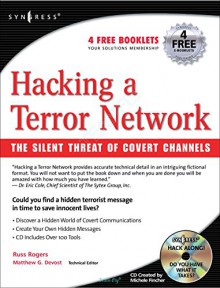From a counter terrorism perspective, discovering terrorist communication networks and methods is extremely important.Terrorists have demonstrated the capability to exchange messages that vary from archaic (using human couriers) to technologically advanced using “virtual dead-drops.”The popular...
show more
From a counter terrorism perspective, discovering terrorist communication networks
and methods is extremely important.Terrorists have demonstrated the
capability to exchange messages that vary from archaic (using human couriers)
to technologically advanced using “virtual dead-drops.”The popular press is full
of stories regarding terrorists communicating using networks like the Internet,
and there is practical evidence to support the stories that have been discovered
on terrorists’ desktops and laptops from the U.S. to Europe to Pakistan and
Afghanistan.
The Internet provides a viable and varied communication forum for terrorists,
and the global distributed nature of the Internet makes attribution nearly
impossible in many cases.We know that after he was profiled from his first
flight, the shoe bomber is alleged to have sent e-mail to superiors asking if he
should continue with his attack.We know that bin Laden himself used satellite
phones for communication and drafted e-mail messages to coordinate activities
with remote cells or to handle administrative matters within Al Qaeda.We
know that terrorists have demonstrated an ability to adapt, and it is safe to
assume that their communication capabilities will also adapt, enabling them to
communicate more securely.
In Hacking a Terror Network, Russ Rogers uses a fictional scenario to demonstrate
how terrorists may use the Internet to coordinate and launch a new series
of terrorist attacks.While the scenario may be fictitious, the techniques and
technologies that Russ uses are drawn straight from the computer security
world, making this not only an interesting literary read but also a technical
manual on how covert channels work and how law enforcement and intelligence
organizations can go about discovering and defeating them.This book is
packed with real-life examples of how tools work, including screenshots and
narrative tutorials. Both amateurs and seasoned security professionals will benefit
from reading this book.
Russ’s experience within the U.S. Defense Department, as part of the intelligence
community, and as an expert in the computer security industry uniquely positions him to make this an interesting and technically viable read. I’ve often enjoyed my conversations with Russ on a variety of topics at Black Hat and other security industry conferences. He is known for having his finger on the pulse of the industry and for being able to identify trends and emerging issues.The story entertained me, and as a security expert, I can honestly say I learned something from reading this book.
With the arrest of Muhammad Naeem Noor Khan in Pakistan in the summer of 2004, we got a rare glimpse into the logistical and technological effort put forth by Al Qaeda by observing the activities of one of its top technologists. With the Madrid attacks, we saw how terrorist organizations can be self-organizing based on principles that look a lot like scientific theories on emergence.The Internet provides the perfect foundation for another adaptation where cells are self-organizing based solely on interaction over the Internet.
What if a lone computer scientist living in the West wanted to join Al Qaeda?
To whom would this person turn? How would this person communicate with
his or her peers and Al Qaeda leadership? This book provides insights into how
such a terrorist connection could be made. Perhaps it is already happening, and
failure to give theories and scenarios like those presented in this book appropriate
credence could have catastrophic consequences. Aside from using the Internet as a communication network, terrorists also use it to case potential targets, to manufacture and distribute propaganda, to recruit supporters, and to solicit funds. How much more sophisticated the terrorists become remains to be seen, but Hacking a Terrorist Network shows how Internet technology can be used to plan an attack.
show less

